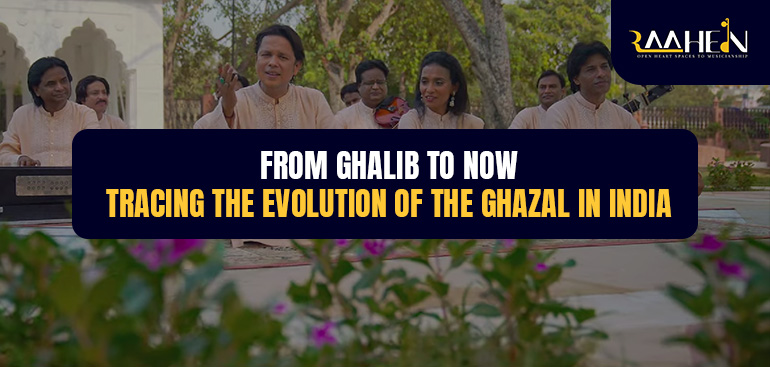The ghazal is more than just a poetic form – it’s an emotional echo of love, loss, and longing that has flowed through centuries of Indian music and literature. From the ornate Urdu couplets of Mirza Ghalib to today’s acoustic reinterpretations, the ghazal continues to evolve without losing its soul.
Let’s explore the historical arc of the ghazal in India – its origins, transformation into song, its cinematic embrace, and its modern-day revivals.
Table of Contents
1. Where It All Began: The Persian and Arabic Roots
The ghazal was born in 7th-century Arabia, rooted in qasida—a longer form of classical Arabic poetry. It found structure and emotional depth in Persian literature, particularly through poets like Rumi, Hafiz, and Saadi. These early ghazals explored spiritual yearning, often framing divine love in metaphors of human romance.
2. The Indian Arrival: Sufis, Khusro, and Urdu Emergence
The ghazal reached Indian shores around the 12th century with the advent of Persian influence under the Delhi Sultanate. It was through the mystic Sufi poet Amir Khusro that the form began to absorb Indian linguistic and cultural elements. By the 18th century, poets like Wali Dakhni and Siraj Aurangabadi transitioned the ghazal from Persian to Urdu, creating a uniquely Indian literary identity.
3. Golden Age of Urdu Poetry: Mir and Ghalib
No discussion of Indian ghazals is complete without mentioning Mir Taqi Mir and Mirza Ghalib.
- Mir brought personal vulnerability and raw emotion to the form.
- Ghalib elevated it into philosophical territory, writing about love, death, God, and the futility of human desire.
Ghalib’s ghazals weren’t just poetry – they were existential revelations, echoing the changing socio-political currents of 19th-century India.
4. From Paper to Performance: When Ghazals Became Music
While ghazals were initially written to be read, they gradually transitioned into performance pieces, particularly during the Mughal era. Classical singers adopted the ghazal for court entertainment, often blending it with thumri and khayal styles.
The ghazal’s lyrical simplicity allowed for deep emotional expression, and its melodic possibilities led to its embrace across diverse Indian classical and semi-classical platforms.
5. 20th Century Legends: Voices That Shaped the Ghazal
The late 20th century was a renaissance period for the ghazal as a musical form:
- Begum Akhtar: Her renditions gave the ghazal its classical legitimacy.
- Mehdi Hassan: Known as the Shahenshah-e-Ghazal, his deep, velvety voice made Urdu poetry accessible to all.
- Jagjit Singh: He revolutionized the genre with simplified arrangements and relatable lyrics, making ghazals a household experience.
Each artist contributed to the democratization of the ghazal—taking it from elite mehfils to radio, cassettes, and living rooms across the country.
6. The Bollywood Era: Ghazals Meet Cinema
From the 1950s through the 1980s, Bollywood played a pivotal role in popularizing ghazals. Films like Pakeezah, Umrao Jaan, and Bazaar gave rise to unforgettable ghazal-based soundtracks.
These “filmi ghazals” often retained the structural integrity of traditional ghazals while introducing cinematic orchestration, reaching mass audiences who may not have engaged with the genre otherwise.
7. The Contemporary Revival: Indie Artists and New Sounds
In the digital age, ghazals are enjoying a quiet resurgence. Artists across India are blending traditional couplets with regional sounds, modern instruments, and fresh themes. This new wave doesn’t just romanticize lost love-it explores mental health, identity, longing for peace, and inner beauty.
A recent example is the ghazal Khoobsurat by RAAHEIN Gharana, which blends classical Urdu lyricism with acoustic arrangements and rare Indian instruments-showcasing how the ghazal continues to find new life in meaningful ways.
8. Why the Ghazal Still Resonates Today
- Emotional Universality: Themes of longing, loss, hope, and connection remain timeless.
- Structural Elegance: The strict meter and rhyme lend the form a lyrical beauty that modern free verse often lacks.
- Spiritual and Secular Harmony: Whether devoted to a beloved or the divine, ghazals speak to both heart and soul.
- Regional Adaptability: Today’s ghazals are performed not only in Urdu but also in Hindi, Punjabi, Bengali, and even Marathi.
Final Thoughts
The ghazal has never been static. It has adapted to courts, films, living rooms, and now, smartphones. From the ink-stained verses of Ghalib to contemporary expressions that cherish inner truth and cultural roots, the ghazal stands tall as India’s most enduring poetic gift to the world.
Whether you listen to a vintage Jagjit Singh cassette or stream a minimalist acoustic ghazal today, you’re engaging with a tradition that’s centuries old – and still evolving.

